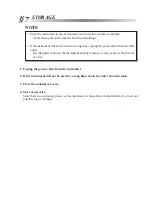
5 - 8
5.4.1 When the edger is not connected to the barcode scanner
The internal memory built into the standard type of instrument can store and manage the traced
outline and lens layout data of 100 sets of frames.
<Storing method>
1. Read the traced data.
2. Set the parameter “Ext. interface” to “None”.
3. Input layout data if necessary.
4. Align the cursor (
) to “MEM” with
.
5. Select the memory address
*2
from the 001 to
100 range with
or
.
The indication of an address whose data has
already been stored is highlighted.
6. Press
to store data such as traced
outline, lens layout, lens material, frame
type, processing mode, and the polishing
mode (ON/OFF).
<Method for calling up>
To call up the traced outline only, set the parameter “11) Layout memory” to “None” in advance
(see p. 5-4).
1. Align the cursor to “MEM” with
.
2. Select the memory address with
or
.
The indication of an address whose data has already been stored is highlighted.
3. Hold
down until the instrument produces two electrical beeps.
The traced outline will appear on the Layout screen.
*2 Memory address shows the data address at which the traced data and layout data are stored. If
you store new data under the address at which data has been already stored, the former data
will be erased.
㧚ޓ
㧚ޓ
ޓ㧚
㧚ޓ
㧹㧵㧺ޓޓ㧢㧡
㧲㧼㧰㧦㧢㧥㧜㧜ޓޓޓޓޓޓޓޓ
㧲㧼㧰㧦㧢㧥㧜㧜ޓޓޓޓޓޓޓޓ
㧼㧰ޓ㧦㧢㧞㧜㧜ޓޓޓޓޓޓޓޓ
㧼㧰ޓ㧦㧢㧞㧜㧜ޓޓޓޓޓޓޓޓ
ޓޓޓ㧦ޓޓ㧞㧜ޓޓޓޓޓޓޓޓ
ޓޓޓ㧦ޓޓ㧞㧜ޓޓޓޓޓޓޓޓ
㧿㧵㨆㧦ޓ㧜㧞㧜ޓޓޓޓޓޓޓޓ
㧿㧵㨆㧦ޓ㧜㧞㧜ޓޓޓޓޓޓޓޓ
㧭㧯㨀ޓޓޓޓޓޓޓޓޓޓޓޓޓ
㧭㧯㨀ޓޓޓޓޓޓޓޓޓޓޓޓޓ
㧹㧱㧹
㧹㧱㧹
㧦ޓ㧝㧜㧜ޓޓޓޓޓޓޓޓ
㧦ޓ㧝㧜㧜ޓޓޓޓޓޓޓޓ
㧼㧸㧭
㧼㧸㧭㧺㨅㧸㧭㨁㨀㧼㧻㧸
㧺㨅㧸㧭㨁㨀㧼㧻㧸 ޓ㧾
ޓ㧾
Memory address
Summary of Contents for LE-9000DX Express
Page 1: ...NIDEK PATTERNLESS EDGER LE 9000EX Express LE 9000DX Express OPERATOR SMANUAL...
Page 17: ...2 9 or or Top view...
Page 19: ...2 11...
Page 153: ......
































